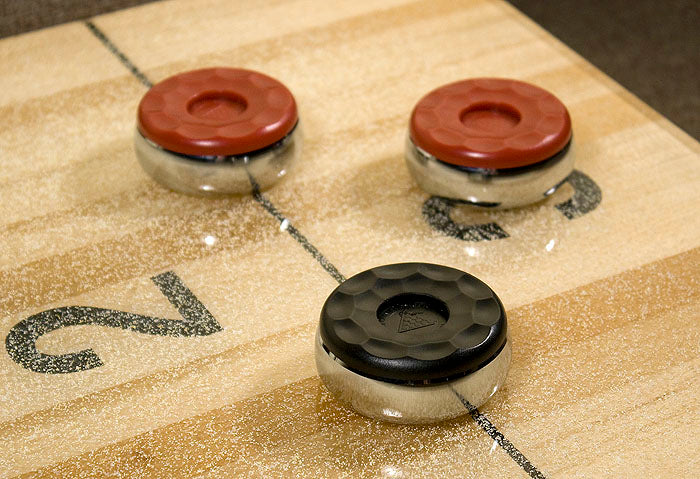Last summer, we went to a cousin’s graduation party for one of his sons. It was an outdoor party and there’s nothing better than a couple of cold ones in the hot sun – or so I thought. After a few hours, all the dads were redirected to a neighbor’s basement where there was a pool table, a shuffleboard and a full bar. But the real showcase was the “game clinic” put on by the host!
This guy was a retired U.S. Army Vietnam War vet who got bored with bus trips to the casino and has spent the last ten of his “golden years” competing in pool leagues and shuffleboard tournaments. I’ve seen my share of great pool players in my life, but I’ve never seen anyone play shuffleboard like my new friend. And talk about the ultimate host, he was taking time to teach us how to play better (in addition to the “Jordan-esque” show he put on during our games). He even had a cool nickname – Kilgore – inspired by the Robert Duvall character in the movie Apocalypse Now.
Even though it’s one of the all-time favorite drinking games, shuffleboard has a science to it where technique and strategy can make the playing experience very enjoyable. Here are a few tips and strategies that Kilgore taught me:
Own your technique. Quoting from William Ernest Henley’s Invictus poem, he said when it comes to technique, you have to be the “Captain of your soul, the master of your fate.”
- Don’t grip the puck too tight. Hold it lightly with your thumb, index and middle finger using your remaining fingers as a guide (also known as side-wheeling).
- Develop a balanced stance with feet spread apart shoulder length and lean forward slightly enough so that your weight stays centered over your feet.
- Practice using a smooth, fluid stroke with a gentle release and a little “English” that helps you control the speed and accuracy of the puck on its slide.
- Use the rail as a guide, especially for straight shots.
- Most importantly, PRACTICE, PRACTICE, PRACTICE! Learn how to master your technique so that your pucks consistently land in high-scoring positions, as well as in the desired places on the board for knocking and blocking your opponent’s pucks.
Winning Strategies: Blocking, Knocking, Planning & Reading
- Always plan your next 1-2 shots while taking your current shot. Think about how your shot placements impact your opponent’s ability to score and be willing to adjust your plan based on your opponent’s skill and strategy.
- Use blocking, knocking and scoring to read your opponent. You could shoot your first puck into a 2-point or 3-point position to see if your opponent attempts to knock your off or aims for another scoring position on the board (and see how accurate your opponent’s shots are). You can also shoot your puck into a blocking position to see how your opponent reacts.
- Read the board. Insist on a few practice shots before playing a game. Figure out how fast or slow the puck moves and adjust your slide accordingly. Take practice shots throughout the board and from both sides so you can check for any soft spots.
That night we played in his basement, Kilgore incorporated numerous strategies and game plan audibles to make every shot count. He liked quoting Eisenhower’s description of the D-Day success: “the plan was nothing. Planning is everything.” Kilgore’s game was like a military invasion. He could knock opponents’ pucks off and his would land in scoring positions that hid behind his blocks. He employed several trick shots where pucks moved in mind-boggling directions. And he never lost once.
Kilgore offered to teach me how to make these trick shots but only if I practice as much as he did. And he promised that practicing can be the most fun, especially as you continue to improve your game. So, I look forward to a return trip hopefully soon. I’ll be sure to share the trick shot secrets in future blogs.
Blog Provided by Don Browne - Wordsmith Extraordinaire - Game Room Enthusiast





